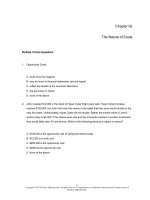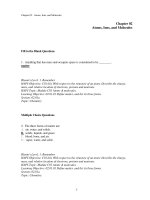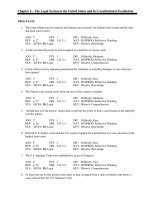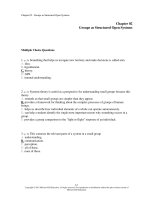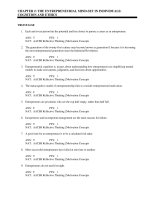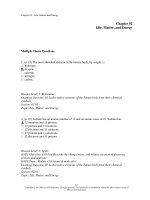Maders understanding human anatomy and physiology 9th edition longenbaker test bank
Bạn đang xem bản rút gọn của tài liệu. Xem và tải ngay bản đầy đủ của tài liệu tại đây (205.79 KB, 40 trang )
Chapter 02 - Chemistry of Life
Chapter 02
Chemistry of Life
Multiple Choice Questions
1. The smallest unit of matter is the
A. molecule.
B. atom.
C. compound.
D. isotope.
Bloom's Level: 1. Remember
HAPS Objective: C.01.03 Compare and contrast the terms atoms, molecules, elements, and compounds.
Learning Outcome: 02.01
Section: 02.01
Topic: Atoms and molecules
2. An element is any substance that contains one type of
A. molecule.
B. isotope.
C. atom.
D. proton.
Bloom's Level: 1. Remember
HAPS Objective: C.01.03 Compare and contrast the terms atoms, molecules, elements, and compounds.
Learning Outcome: 02.01
Section: 02.01
Topic: Atoms and molecules
2-1
Copyright © 2017 McGraw-Hill Education. All rights reserved. No reproduction or distribution without the prior written consent of
McGraw-Hill Education.
Chapter 02 - Chemistry of Life
True / False Questions
3. Over 90% of the body is composed of four elements: carbon, nitrogen, chlorine, and
hydrogen.
FALSE
Bloom's Level: 1. Remember
HAPS Objective: C.01.03 Compare and contrast the terms atoms, molecules, elements, and compounds.
Learning Outcome: 02.01
Section: 02.01
Topic: Atoms and molecules
Multiple Choice Questions
4. The positively charged particles in the nucleus of an atom are
A. neutrons.
B. electrons.
C. protons.
D. isotopes.
Bloom's Level: 1. Remember
HAPS Objective: C.01.01a Describe the charge, mass, and relative location of electrons, protons and neutrons with respect to the structure
of an atom
Learning Outcome: 02.01
Section: 02.01
Topic: Atoms and molecules
5. The atomic mass of a proton is
A. 0 atomic mass units.
B. 2 atomic mass units.
C. 1 atomic mass units.
D. –1 atomic mass units.
Bloom's Level: 1. Remember
HAPS Objective: C.01.01d Distinguish among the terms atomic number, mass number and atomic weight with respect to the structure of an
atom
Learning Outcome: 02.01
Section: 02.01
Topic: Atoms and molecules
2-2
Copyright © 2017 McGraw-Hill Education. All rights reserved. No reproduction or distribution without the prior written consent of
McGraw-Hill Education.
Chapter 02 - Chemistry of Life
6. Which of the following subatomic particles are found in the nucleus of an atom?
A. Protons and electrons
B. Electrons and neutrons
C. Protons and shells
D. Neutrons and protons
Bloom's Level: 1. Remember
HAPS Objective: C.01.01a Describe the charge, mass, and relative location of electrons, protons and neutrons with respect to the structure
of an atom
Learning Outcome: 02.01
Section: 02.01
Topic: Atoms and molecules
7. The number of protons in an atom is called the
A. atomic number.
B. atomic weight.
C. mass number.
D. combining weight.
Bloom's Level: 1. Remember
HAPS Objective: C.01.01a Describe the charge, mass, and relative location of electrons, protons and neutrons with respect to the structure
of an atom
Learning Outcome: 02.01
Section: 02.01
Topic: Atoms and molecules
8. Which subatomic particle determines the identity of an atom?
A. Neutron
B. Proton
C. Electron
D. Prion
Bloom's Level: 1. Remember
HAPS Objective: C.01.01a Describe the charge, mass, and relative location of electrons, protons and neutrons with respect to the structure
of an atom
HAPS Objective: C.01.01d Distinguish among the terms atomic number, mass number and atomic weight with respect to the structure of an
atom
Learning Outcome: 02.01
Section: 02.01
Topic: Atoms and molecules
2-3
Copyright © 2017 McGraw-Hill Education. All rights reserved. No reproduction or distribution without the prior written consent of
McGraw-Hill Education.
Chapter 02 - Chemistry of Life
9. Which subatomic particle determines the chemical activity of an atom?
A. Neutron
B. Proton
C. Electron
D. Prion
Bloom's Level: 1. Remember
HAPS Objective: C.01.01b Relate the number of electrons in an electron shell to an atoms chemical stability and its ability to form chemical
bonds.
Learning Outcome: 02.01
Section: 02.01
Topic: Atoms and molecules
10. Which is characteristic of an ion?
A. Contains an unequal number of electrons and protons
B. Contains a different number of neutrons
C. Contains extra protons
D. Contains equal numbers of protons, electrons, and neutrons
Bloom's Level: 1. Remember
HAPS Objective: C.01.01c Explain how ions and isotopes are produced by changing the relative number of specific subatomic particles with
respect to the structure of an atom
Learning Outcome: 02.01
Section: 02.01
Topic: Atoms and molecules
11. The number of an element is equal to
A. protons plus the number of neutrons.
B. protons plus the number of electrons.
C. protons.
D. electrons plus the number of neutrons.
Bloom's Level: 1. Remember
HAPS Objective: C.01.01d Distinguish among the terms atomic number, mass number and atomic weight with respect to the structure of an
atom
Learning Outcome: 02.01
Section: 02.01
Topic: Atoms and molecules
2-4
Copyright © 2017 McGraw-Hill Education. All rights reserved. No reproduction or distribution without the prior written consent of
McGraw-Hill Education.
Chapter 02 - Chemistry of Life
12. An atom or group of atoms with a charge is called a(n)
A. molecule.
B. isotope.
C. compound.
D. ion.
Bloom's Level: 1. Remember
HAPS Objective: C.01.02 Compare and contrast the terms ions, electrolytes, free radicals, isotopes and radioisotopes
Learning Outcome: 02.03
Section: 02.01
Topic: Atoms and molecules
13. Atoms with more than one shell are most stable when the outermost shell contains _____
electrons.
A. 10
B. 1
C. 8
D. 6
Bloom's Level: 1. Remember
HAPS Objective: C.01.01b Relate the number of electrons in an electron shell to an atoms chemical stability and its ability to form chemical
bonds.
Learning Outcome: 02.01
Section: 02.01
Topic: Atoms and molecules
14. Exactly 6.02 x 1023 atoms of any element is called one ____ of that element.
A. atomic mass unit
B. isotope
C. mole
D. mouse
Bloom's Level: 1. Remember
HAPS Objective: C.01.01d Distinguish among the terms atomic number, mass number and atomic weight with respect to the structure of an
atom
Learning Outcome: 02.01
Section: 02.01
Topic: Atoms and molecules
2-5
Copyright © 2017 McGraw-Hill Education. All rights reserved. No reproduction or distribution without the prior written consent of
McGraw-Hill Education.
Chapter 02 - Chemistry of Life
15. Different forms of the same element with different numbers of neutrons are called
A. molecules.
B. compounds.
C. isotopes.
D. lattices.
Bloom's Level: 1. Remember
HAPS Objective: C.01.01c Explain how ions and isotopes are produced by changing the relative number of specific subatomic particles with
respect to the structure of an atom
Learning Outcome: 02.01
Section: 02.01
Topic: Atoms and molecules
16. If the atomic number of an element is 9 and the mass number is 19, how many neutrons
does the atom have?
A. 10
B. 9
C. 19
D. 28
Bloom's Level: 3. Apply
HAPS Objective: C.01.01d Distinguish among the terms atomic number, mass number and atomic weight with respect to the structure of an
atom
Learning Outcome: 02.01
Section: 02.01
Topic: Atoms and molecules
17. If the atomic number of an element is 27 and the mass number is 60, how many neutrons
does the atom have?
A. 27
B. 33
C. 87
D. 60
Bloom's Level: 3. Apply
HAPS Objective: C.01.01d Distinguish among the terms atomic number, mass number and atomic weight with respect to the structure of an
atom
Learning Outcome: 02.01
Section: 02.01
Topic: Atoms and molecules
2-6
Copyright © 2017 McGraw-Hill Education. All rights reserved. No reproduction or distribution without the prior written consent of
McGraw-Hill Education.
Chapter 02 - Chemistry of Life
18. Compared to "regular" isotopes, radioactive isotopes
A. emit energy from the nucleus.
B. lose or gain neutrons.
C. lose or gain electrons.
Bloom's Level: 1. Remember
HAPS Objective: C.01.02 Compare and contrast the terms ions, electrolytes, free radicals, isotopes and radioisotopes
Learning Outcome: 02.02
Section: 02.01
Topic: Atoms and molecules
19. Low levels of radiation are commonly used to
A. sterilize dental products.
B. destroy cancer cells.
C. produce images of body parts.
D. All apply.
Bloom's Level: 1. Remember
HAPS Objective: C.01.02 Compare and contrast the terms ions, electrolytes, free radicals, isotopes and radioisotopes
Learning Outcome: 02.02
Section: 02.01
Topic: Atoms and molecules
20. What makes an isotope radioactive?
A. It has more protons than electrons.
B. It releases energy to become stable.
C. It releases hydrogen ions into solution.
D. It breaks down into hydrogen and electrons.
Bloom's Level: 2. Understand
HAPS Objective: C.01.02 Compare and contrast the terms ions, electrolytes, free radicals, isotopes and radioisotopes
Learning Outcome: 02.02
Section: 02.01
Topic: Atoms and molecules
2-7
Copyright © 2017 McGraw-Hill Education. All rights reserved. No reproduction or distribution without the prior written consent of
McGraw-Hill Education.
Chapter 02 - Chemistry of Life
21. High levels of radiation are NOT used
A. to sterilize medical equipment.
B. to kill cancer cells.
C. as tracers to detect molecular changes.
D. to sterilize medical tools and equipment.
Bloom's Level: 1. Remember
HAPS Objective: C.01.02 Compare and contrast the terms ions, electrolytes, free radicals, isotopes and radioisotopes
Learning Outcome: 02.02
Section: 02.01
Topic: Atoms and molecules
22. Atoms bonded together to form a chemical unit are called
A. molecules.
B. ions.
C. radioisotopes.
D. buffers.
Bloom's Level: 1. Remember
HAPS Objective: C.01.03 Compare and contrast the terms atoms, molecules, elements, and compounds.
Learning Outcome: 02.03
Section: 02.01
Topic: Atoms and molecules
Topic: Chemical bonding
23. Molecules form from
A. the shape of the individual atoms.
B. the attraction between electrons.
C. the sharing of electrons.
D. a drive toward solubility.
Bloom's Level: 1. Remember
HAPS Objective: C.02.01b Explain the mechanism of each type of bond With respect to non-polar covalent, polar covalent, ionic, and
hydrogen bonds
Learning Outcome: 02.03
Section: 02.01
Topic: Chemical bonding
2-8
Copyright © 2017 McGraw-Hill Education. All rights reserved. No reproduction or distribution without the prior written consent of
McGraw-Hill Education.
Chapter 02 - Chemistry of Life
24. A molecule made of two or more different atoms bonded together is called a(n)
A. ion.
B. isotope.
C. atom.
D. compound.
Bloom's Level: 1. Remember
HAPS Objective: C.01.03 Compare and contrast the terms atoms, molecules, elements, and compounds.
Learning Outcome: 02.03
Section: 02.01
Topic: Atoms and molecules
Topic: Chemical bonding
25. An anion is an atom or molecule that
A. is positively charged.
B. is negatively charged.
C. emits radioactive energy.
Bloom's Level: 1. Remember
HAPS Objective: C.01.02 Compare and contrast the terms ions, electrolytes, free radicals, isotopes and radioisotopes
Learning Outcome: 02.01
Section: 02.01
Topic: Atoms and molecules
26. A bond created from the attraction between positively and negatively charged ions is a(n)
______ bond.
A. covalent
B. hydrogen
C. ionic
D. metallic
Bloom's Level: 1. Remember
HAPS Objective: C.02.01b Explain the mechanism of each type of bond With respect to non-polar covalent, polar covalent, ionic, and
hydrogen bonds
Learning Outcome: 02.03
Section: 02.01
Topic: Chemical bonding
2-9
Copyright © 2017 McGraw-Hill Education. All rights reserved. No reproduction or distribution without the prior written consent of
McGraw-Hill Education.
Chapter 02 - Chemistry of Life
27. Sodium chloride dissociates when dissolved in water. Therefore, it is considered a
______.
A. salt
B. compound
C. acid
D. base
Bloom's Level: 1. Remember
HAPS Objective: C.03.03 Define the term salt and give examples of physiological significance.
Learning Outcome: 02.03
Section: 02.01
Topic: Chemical bonding
28. A bond created from the sharing of electrons between two atoms is a(n) ______ bond.
A. covalent
B. hydrogen
C. ionic
D. metallic
Bloom's Level: 1. Remember
HAPS Objective: C.02.01b Explain the mechanism of each type of bond With respect to non-polar covalent, polar covalent, ionic, and
hydrogen bonds
Learning Outcome: 02.03
Section: 02.01
Topic: Chemical bonding
29. When two pairs of electrons are shared between two atoms, a ______ bond is formed.
A. single covalent
B. double covalent
C. triple covalent
D. double ionic
Bloom's Level: 1. Remember
HAPS Objective: C.02.01b Explain the mechanism of each type of bond With respect to non-polar covalent, polar covalent, ionic, and
hydrogen bonds
Learning Outcome: 02.03
Section: 02.01
Topic: Chemical bonding
2-10
Copyright © 2017 McGraw-Hill Education. All rights reserved. No reproduction or distribution without the prior written consent of
McGraw-Hill Education.
Chapter 02 - Chemistry of Life
30. When one atom has a stronger attraction for shared electrons than the other atom, a(n)
___________ covalent bond is formed.
A. polar
B. nonpolar
C. ionic
D. metallic
Bloom's Level: 1. Remember
HAPS Objective: C.02.01b Explain the mechanism of each type of bond With respect to non-polar covalent, polar covalent, ionic, and
hydrogen bonds
Learning Outcome: 02.03
Section: 02.01
Topic: Chemical bonding
31. Ionic bonds involve _______, while covalent bonds involve _______.
A. the donation of electrons; the sharing of electrons
B. the sharing of electrons; the donation of electrons
C. weak attractions; the donation of electrons
Bloom's Level: 1. Remember
HAPS Objective: C.02.01b Explain the mechanism of each type of bond With respect to non-polar covalent, polar covalent, ionic, and
hydrogen bonds
Learning Outcome: 02.03
Section: 02.01
Topic: Chemical bonding
32. Equal sharing of electrons is a characteristic of a _______ covalent bond, while unequal
sharing is in a _______ bond.
A. polar; nonpolar
B. nonpolar; polar
Bloom's Level: 1. Remember
HAPS Objective: C.02.01b Explain the mechanism of each type of bond With respect to non-polar covalent, polar covalent, ionic, and
hydrogen bonds
Learning Outcome: 02.03
Section: 02.01
Topic: Chemical bonding
2-11
Copyright © 2017 McGraw-Hill Education. All rights reserved. No reproduction or distribution without the prior written consent of
McGraw-Hill Education.
Chapter 02 - Chemistry of Life
33. The most abundant molecule in living organisms is
A. water.
B. glucose.
C. oxygen.
D. ammonia.
Bloom's Level: 1. Remember
HAPS Objective: C.03.01 Discuss the physiologically important properties of water.
Learning Outcome: 02.04
Section: 02.02
Topic: Inorganic compounds and solutions
34. Organic compounds always contain ___________ atoms.
A. water
B. carbon
C. nitrogen
D. oxygen
Bloom's Level: 1. Remember
HAPS Objective: C.04.04b Compare and contrast general molecular structure With respect to carbohydrates, proteins, lipids and, nucleic
acids
Learning Outcome: 02.04
Section: 02.02
Topic: Atoms and molecules
35. Water molecules are
A. polar.
B. nonpolar.
Bloom's Level: 1. Remember
HAPS Objective: C.03.01 Discuss the physiologically important properties of water.
Learning Outcome: 02.04
Section: 02.02
Topic: Inorganic compounds and solutions
2-12
Copyright © 2017 McGraw-Hill Education. All rights reserved. No reproduction or distribution without the prior written consent of
McGraw-Hill Education.
Chapter 02 - Chemistry of Life
36. The attraction between a slightly positive hydrogen to a slightly negative oxygen of
another molecule describes a(n) ________ bond.
A. hydrogen
B. oxygen
C. nitrogen
D. ionic
Bloom's Level: 1. Remember
HAPS Objective: C.02.01b Explain the mechanism of each type of bond With respect to non-polar covalent, polar covalent, ionic, and
hydrogen bonds
Learning Outcome: 02.04
Section: 02.02
Topic: Chemical bonding
37. Which of the following is NOT a property of water?
A. High heat capacity
B. Low heat of vaporization
C. Solvent for polar and ionic compounds
D. Cohesiveness
Bloom's Level: 1. Remember
HAPS Objective: C.03.01 Discuss the physiologically important properties of water.
Learning Outcome: 02.04
Section: 02.02
Topic: Inorganic compounds and solutions
38. Which of the following is NOT a property of water?
A. The ability to cling to other water molecules, yet flow
B. The ability to facilitate chemical reactions
C. The ability to insulate the body from temperature extremes
D. The ability to dissolve nonpolar, hydrophobic molecules
Bloom's Level: 1. Remember
HAPS Objective: C.03.01 Discuss the physiologically important properties of water.
HAPS Objective: C.03.02 Distinguish among the terms solution, solute, solvent, colloid suspension, and emulsion.
Learning Outcome: 02.04
Section: 02.02
Topic: Inorganic compounds and solutions
2-13
Copyright © 2017 McGraw-Hill Education. All rights reserved. No reproduction or distribution without the prior written consent of
McGraw-Hill Education.
Chapter 02 - Chemistry of Life
39. Substances that dissolve in water are called
A. hydrophilic.
B. hydrophobic.
C. hydrophoric.
D. hydrochromic.
Bloom's Level: 1. Remember
HAPS Objective: C.03.01 Discuss the physiologically important properties of water.
Learning Outcome: 02.04
Section: 02.02
Topic: Inorganic compounds and solutions
40. The ability of water molecules to cling to each other is _________, while the ability to
cling to other surfaces is ___________.
A. cohesion; adhesion
B. dissolving; vaporization
C. adhesion; cohesion
D. cohesion; dissolving
Bloom's Level: 1. Remember
HAPS Objective: C.03.01 Discuss the physiologically important properties of water.
Learning Outcome: 02.04
Section: 02.02
Topic: Inorganic compounds and solutions
41. The ability of water to absorb large amounts of heat energy without changing its
temperature is a
A. low specific heat capacity.
B. low heat of vaporization.
C. high specific heat capacity.
D. high heat of vaporization.
Bloom's Level: 1. Remember
HAPS Objective: C.03.01 Discuss the physiologically important properties of water.
Learning Outcome: 02.04
Section: 02.02
Topic: Inorganic compounds and solutions
2-14
Copyright © 2017 McGraw-Hill Education. All rights reserved. No reproduction or distribution without the prior written consent of
McGraw-Hill Education.
Chapter 02 - Chemistry of Life
42. A substance that dissociates in water, releasing hydrogen ions, is a(n)
A. salt.
B. base.
C. protein.
D. acid.
Bloom's Level: 1. Remember
HAPS Objective: C.03.04 Define the terms pH, acid, base, and buffer and give examples of physiological significance.
Learning Outcome: 02.05
Section: 02.02
Topic: Inorganic compounds and solutions
43. A substance that can take up hydrogen ions or release hydroxide ions in water is a(n)
A. salt.
B. base.
C. protein.
D. acid.
Bloom's Level: 1. Remember
HAPS Objective: C.03.04 Define the terms pH, acid, base, and buffer and give examples of physiological significance.
Learning Outcome: 02.05
Section: 02.02
Topic: Inorganic compounds and solutions
44. Hydrochloric acid is considered a strong acid because it
A. produces very few hydrogen ions in water.
B. produces many hydroxide ions in water.
C. produces many hydrogen ions in water.
D. dissociates very little in water.
Bloom's Level: 2. Understand
HAPS Objective: C.03.04 Define the terms pH, acid, base, and buffer and give examples of physiological significance.
Learning Outcome: 02.05
Section: 02.02
Topic: Inorganic compounds and solutions
2-15
Copyright © 2017 McGraw-Hill Education. All rights reserved. No reproduction or distribution without the prior written consent of
McGraw-Hill Education.
Chapter 02 - Chemistry of Life
True / False Questions
45. A weak base will accept many hydrogen ions, while a strong base will accept only a few
hydrogen ions.
FALSE
A strong base will accept many hydrogen ions.
Bloom's Level: 2. Understand
HAPS Objective: C.03.04 Define the terms pH, acid, base, and buffer and give examples of physiological significance.
Learning Outcome: 02.05
Section: 02.02
Topic: Inorganic compounds and solutions
Multiple Choice Questions
46. The lower the pH,
A. the lesser the hydrogen ion concentration.
B. the more acidic the solution.
C. the lesser the hydrogen ion concentration and the more acidic the solution.
D. the greater the hydroxide ion concentration.
E. the more basic the solution and the greater the hydroxide ion concentration.
Bloom's Level: 1. Remember
HAPS Objective: C.03.05 State acidic, neutral, and alkaline pH values.
Learning Outcome: 02.06
Section: 02.02
Topic: Inorganic compounds and solutions
2-16
Copyright © 2017 McGraw-Hill Education. All rights reserved. No reproduction or distribution without the prior written consent of
McGraw-Hill Education.
Chapter 02 - Chemistry of Life
47. The pH of the blood is slightly basic. Which of the following describes this pH?
A. 6.4
B. 12.6
C. 4.7
D. 7.4
Bloom's Level: 1. Remember
HAPS Objective: C.03.05 State acidic, neutral, and alkaline pH values.
Learning Outcome: 02.06
Section: 02.02
Topic: Inorganic compounds and solutions
48. A pH of 5.5 would be considered
A. acidic.
B. basic.
C. neutral.
Bloom's Level: 1. Remember
HAPS Objective: C.03.05 State acidic, neutral, and alkaline pH values.
Learning Outcome: 02.06
Section: 02.02
Topic: Inorganic compounds and solutions
49. A pH of 7.0 would be considered
A. acidic.
B. basic.
C. neutral.
Bloom's Level: 1. Remember
HAPS Objective: C.03.05 State acidic, neutral, and alkaline pH values.
Learning Outcome: 02.06
Section: 02.02
Topic: Inorganic compounds and solutions
2-17
Copyright © 2017 McGraw-Hill Education. All rights reserved. No reproduction or distribution without the prior written consent of
McGraw-Hill Education.
Chapter 02 - Chemistry of Life
50. A blood pH of 7.2 would be considered _______, while a pH of 7.6 would be _______.
A. acidosis; alkalosis
B. alkalosis; acidosis
C. acidosis; normal
D. Both values are within the normal range.
Bloom's Level: 1. Remember
HAPS Objective: C.03.04 Define the terms pH, acid, base, and buffer and give examples of physiological significance.
HAPS Objective: C.03.05 State acidic, neutral, and alkaline pH values.
Learning Outcome: 02.06
Section: 02.02
Topic: Inorganic compounds and solutions
51. Chemicals that help keep body fluids within a normal pH range are called
A. acids.
B. bases.
C. buffers.
D. salts.
Bloom's Level: 1. Remember
HAPS Objective: C.03.05 State acidic, neutral, and alkaline pH values.
Learning Outcome: 02.06
Section: 02.02
Topic: Inorganic compounds and solutions
52. An electrolyte is a substance that releases _____ when dissolved in water.
A. ions
B. electrons
C. bases
Bloom's Level: 1. Remember
HAPS Objective: C.01.02 Compare and contrast the terms ions, electrolytes, free radicals, isotopes and radioisotopes
HAPS Objective: C.03.03 Define the term salt and give examples of physiological significance.
Learning Outcome: 02.06
Section: 02.02
Topic: Inorganic compounds and solutions
2-18
Copyright © 2017 McGraw-Hill Education. All rights reserved. No reproduction or distribution without the prior written consent of
McGraw-Hill Education.
Chapter 02 - Chemistry of Life
Check All That Apply Questions
53. Which four are the main macromolecules found in cells?
__X__ Proteins
_____ Water
__X__ Carbohydrates
__X__ Nucleic acids
__X__ Lipids
Bloom's Level: 1. Remember
HAPS Objective: C.04.04a Identify the monomers and polymers With respect to carbohydrates, proteins, lipids and, nucleic acids
Learning Outcome: 02.07
Section: 02.03
Topic: Organic compounds
Multiple Choice Questions
54. What monomer is NOT correctly matched with its macromolecule?
A. carbohydrates - glucose
B. lipids - glycerol and citric acids
C. proteins - amino acids
D. nucleic acids - nucleotides
Bloom's Level: 1. Remember
HAPS Objective: C.04.04a Identify the monomers and polymers With respect to carbohydrates, proteins, lipids and, nucleic acids
Learning Outcome: 02.08
Section: 02.03
Topic: Organic compounds
2-19
Copyright © 2017 McGraw-Hill Education. All rights reserved. No reproduction or distribution without the prior written consent of
McGraw-Hill Education.
Chapter 02 - Chemistry of Life
55. The subunit molecules for proteins are
A. nucleic acids.
B. amino acids.
C. fatty acids.
D. monosaccharides.
Bloom's Level: 1. Remember
HAPS Objective: C.04.04a Identify the monomers and polymers With respect to carbohydrates, proteins, lipids and, nucleic acids
Learning Outcome: 02.08
Section: 02.03
Topic: Organic compounds
56. Which arrow in the following equation represents dehydration?
A. Arrow 1
B. Arrow 2
Bloom's Level: 2. Understand
HAPS Objective: C.04.03 Define and give examples of dehydration synthesis and hydrolysis reactions.
Learning Outcome: 02.07
Section: 02.03
Topic: Organic compounds
2-20
Copyright © 2017 McGraw-Hill Education. All rights reserved. No reproduction or distribution without the prior written consent of
McGraw-Hill Education.
Chapter 02 - Chemistry of Life
57. The addition of water in an enzyme-catalyzed reaction is a(n) ________ reaction.
A. dehydration
B. hydrolysis
C. exchange
D. neutralization
Bloom's Level: 1. Remember
HAPS Objective: C.04.03 Define and give examples of dehydration synthesis and hydrolysis reactions.
Learning Outcome: 02.07
Section: 02.03
Topic: Organic compounds
58. The removal of a water molecule during a reaction results in
A. breaking a bond.
B. forming an acid.
C. hydrolysis.
D. forming a bond.
Bloom's Level: 2. Understand
HAPS Objective: C.04.02 Explain the relationship between monomers and polymers.
HAPS Objective: C.04.03 Define and give examples of dehydration synthesis and hydrolysis reactions.
Learning Outcome: 02.07
Section: 02.03
Topic: Organic compounds
59. The main function of carbohydrates is to provide
A. cellular energy.
B. insulation.
C. transport molecules.
D. hereditary information.
Bloom's Level: 1. Remember
HAPS Objective: C.04.04e Discuss physiological and structural roles in the human body With respect to carbohydrates, proteins, lipids and,
nucleic acids
Learning Outcome: 02.09
Section: 02.04
Topic: Organic compounds
2-21
Copyright © 2017 McGraw-Hill Education. All rights reserved. No reproduction or distribution without the prior written consent of
McGraw-Hill Education.
Chapter 02 - Chemistry of Life
60. A monosaccharide of five carbons is a
A. hexose sugar.
B. glycerol.
C. fatty acid.
D. pentose sugar.
Bloom's Level: 1. Remember
HAPS Objective: C.04.04a Identify the monomers and polymers With respect to carbohydrates, proteins, lipids and, nucleic acids
HAPS Objective: C.04.04c Provide specific examples With respect to carbohydrates, proteins, lipids and, nucleic acids
Learning Outcome: 02.09
Section: 02.04
Topic: Organic compounds
61. The monomer of carbohydrates is a
A. nucleotide.
B. fatty acid.
C. monosaccharide.
D. amino acid.
Bloom's Level: 1. Remember
HAPS Objective: C.04.04a Identify the monomers and polymers With respect to carbohydrates, proteins, lipids and, nucleic acids
Learning Outcome: 02.09
Section: 02.04
Topic: Organic compounds
62. Which of the following is NOT a monosaccharide?
A. Glucose
B. Fructose
C. Sucrose
D. Galactose
Bloom's Level: 1. Remember
HAPS Objective: C.04.04c Provide specific examples With respect to carbohydrates, proteins, lipids and, nucleic acids
Learning Outcome: 02.09
Section: 02.04
Topic: Organic compounds
2-22
Copyright © 2017 McGraw-Hill Education. All rights reserved. No reproduction or distribution without the prior written consent of
McGraw-Hill Education.
Chapter 02 - Chemistry of Life
63. Which of the following is NOT a disaccharide?
A. Maltose
B. Galactose
C. Lactose
D. Sucrose
Bloom's Level: 1. Remember
HAPS Objective: C.04.04c Provide specific examples With respect to carbohydrates, proteins, lipids and, nucleic acids
Learning Outcome: 02.09
Section: 02.04
Topic: Organic compounds
64. Which of the following contains glucose?
A. Protein
B. Fat
C. Nucleic acid
D. Starch
Bloom's Level: 1. Remember
HAPS Objective: C.04.04a Identify the monomers and polymers With respect to carbohydrates, proteins, lipids and, nucleic acids
Learning Outcome: 02.09
Section: 02.04
Topic: Organic compounds
65. Glycogen is
A. a monosaccharide used for quick energy.
B. a protein found in cell membranes.
C. a polysaccharide used as stored energy in animals.
D. a fat found in margarine.
Bloom's Level: 1. Remember
HAPS Objective: C.04.04c Provide specific examples With respect to carbohydrates, proteins, lipids and, nucleic acids
Learning Outcome: 02.09
Section: 02.04
Topic: Organic compounds
2-23
Copyright © 2017 McGraw-Hill Education. All rights reserved. No reproduction or distribution without the prior written consent of
McGraw-Hill Education.
Chapter 02 - Chemistry of Life
Check All That Apply Questions
66. Which are characteristics of starch? Choose all that apply.
__X__ It is a polysaccharide.
_____ It is a disaccharide.
__X__ It is found in plants.
_____ It is found in animals.
Bloom's Level: 1. Remember
HAPS Objective: C.04.04c Provide specific examples With respect to carbohydrates, proteins, lipids and, nucleic acids
HAPS Objective: C.04.04d Identify dietary sources With respect to carbohydrates, proteins, lipids and, nucleic acids
Learning Outcome: 02.09
Section: 02.04
Topic: Organic compounds
Multiple Choice Questions
67. Which of the following is the main component of fiber in our diet?
A. Glycogen
B. Protein
C. Cellulose
D. Starch
Bloom's Level: 1. Remember
HAPS Objective: C.04.04c Provide specific examples With respect to carbohydrates, proteins, lipids and, nucleic acids
HAPS Objective: C.04.04e Discuss physiological and structural roles in the human body With respect to carbohydrates, proteins, lipids and,
nucleic acids
Learning Outcome: 02.09
Section: 02.04
Topic: Organic compounds
2-24
Copyright © 2017 McGraw-Hill Education. All rights reserved. No reproduction or distribution without the prior written consent of
McGraw-Hill Education.
Chapter 02 - Chemistry of Life
68. Organic compounds that are always insoluble in water are called
A. sugars.
B. lipids.
C. nucleotides.
D. proteins.
Bloom's Level: 1. Remember
HAPS Objective: C.04.04c Provide specific examples With respect to carbohydrates, proteins, lipids and, nucleic acids
Learning Outcome: 02.10
Section: 02.05
Topic: Organic compounds
69. Which of the following is NOT a function of lipids?
A. Long-term energy storage
B. Formation of antibodies
C. Formation of cell membranes
D. Component of sex hormones
Bloom's Level: 1. Remember
HAPS Objective: C.04.04e Discuss physiological and structural roles in the human body With respect to carbohydrates, proteins, lipids and,
nucleic acids
Learning Outcome: 02.10
Section: 02.05
Topic: Organic compounds
True / False Questions
70. Fats are usually liquid at room temperature and oils are solids.
FALSE
Fats are usually solid at room temperature and oils are liquid.
Bloom's Level: 1. Remember
HAPS Objective: C.04.04b Compare and contrast general molecular structure With respect to carbohydrates, proteins, lipids and, nucleic
acids
HAPS Objective: C.04.04c Provide specific examples With respect to carbohydrates, proteins, lipids and, nucleic acids
Learning Outcome: 02.10
Section: 02.05
Topic: Organic compounds
2-25
Copyright © 2017 McGraw-Hill Education. All rights reserved. No reproduction or distribution without the prior written consent of
McGraw-Hill Education.
